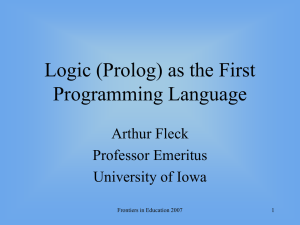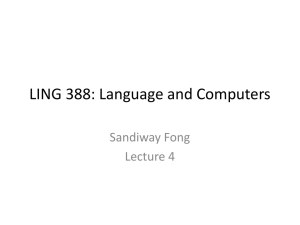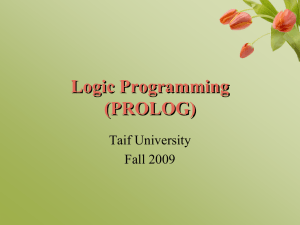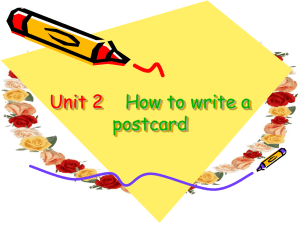ai-prolog
advertisement
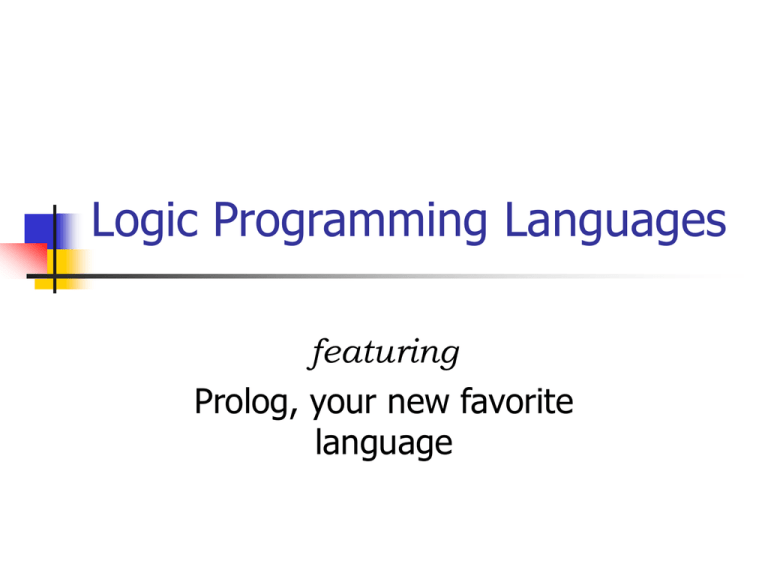
Logic Programming Languages
featuring
Prolog, your new favorite
language
Prolog
PROgramming in LOGic
It is the most widely used logic
programming language
Its development started in 1970
What’s it good for?
Knowledge representation
Natural language processing
State-space searching (Rubik’s cube)
Expert systems, deductive databases, Agents
2
Overview of
Logic Programming
Main idea: Ask the computer to solve
problems using principles of logic:
Program states the known facts
To ask a question, you make a statement
and ask the computer to search for a proof
that the statement is true
Additional mechanisms are provided to
guide the search to find a proof
3
Declarative vs. Imperative
Languages used for logic programming are called
declarative languages because programs written in
them consist of declarations rather than assignment
and flow-of-control statements. These declarations
are statements, or propositions, in symbolic logic.
Programming in imperative languages (e.g., Pascal,
C) and functional languages (e.g., Lisp) is procedural,
which means that the programmer knows what is to
be accomplished by the program and instructs the
computer on exactly how the computation is to be
done.
4
Logic Programming
Programming in logic programming languages
is non-procedural.
Programs in such languages do not state how
a result is to be computed. Instead, we
supply the computer with:
relevant information (facts and rules)
a method of inference for computing desired
results.
Logic programming is based on the predicate
calculus.
5
Logic background
Horn clauses
General form:
IF (A1 and A2 and A3 …) THEN H
Head = H
Body = A1 and A2 and ….
E.g. “If X is positive, and Y is negative,
then Y is less than X”
6
The Predicate Calculus:
Proposition
Proposition:
A proposition is a logical statement, made
up of objects and their relationships to
each other, which may or may not be true.
Examples:
parameters
man(john)
likes(pizza, baseball)
functor
7
The Predicate Calculus:
Logical Connectors
A compound proposition consists of 2 or more
propositions connected by logical connectors,
which include
Negation:
Conjunction:
Disjunction:
Equivalence:
Implication:
a
ab
ab
ab
ab
ab
(“not a”)
(“a and b”)
(“a or b”)
(“a is equivalent to b”)
(“a implies b”)
(“b implies a”)
8
The Predicate Calculus:
Quantifiers
Variables may appear in formulas, but only
when introduced by quantifiers:
Universal quantifier: (for all)
Existential quantifier: (there exists)
Examples:
X (woman(X) human(X))
“All women are human”
X (likes(bill,X) sport(X))
“There is some sport that bill likes”
9
Resolution and Unification
Resolution: how we do logical deduction
from multiple horn clauses:
If the head of horn clause #1 matches one
of the terms in horn clause #2, then we
can replace that term with the body of
clause #1
Unification: How to determine when
the hypotheses are satisfied
10
The Predicate Calculus:
Resolution
Resolution is an inference rule that allows
inferred propositions to be computed from
given propositions.
Suppose we have two propositions
A B (B implies A) and C D (D implies C)
and that A is identical to D. Suppose we
rename A and D as T:
T B and
CT
From this we can infer: C B
11
The Predicate Calculus:
Unification and Instantiation
Unification is the process of finding values
for variables during resolution so that the
matching process can succeed
Instantiation is the temporary binding of a
value (and type) to a variable to allow
unification. A variable is instantiated only
during the resolution process. The
instantiation lasts only as long as it takes to
satisfy one goal.
12
Prolog syntax and terminology
clause = Horn clauses assumed true,
represented “head :- [term [,term]*]”
comma represents logical “and”
clause is fact if: no terms on right of :head and term are both structures:
structure = functor (arg1, arg2,..)
Represents a logical assertion, e.g
teaches(Barbara, class)
13
Prolog syntax and terminology
Constants are numbers or represented
by strings starting with lower-case
Variables start with upper-case letters
A goal or query is a clause with no lefthand side: ?- rainy(seattle)
Tells the Prolog interpreter to see if it can
prove the clause.
14
Facts, Rules And Queries
A collection of facts and rules is called a
Knowledge Base.
Prolog programs are Knowledgebases
You use a Prolog program by posing
queries.
15
Using KnowledgeBase
Woman(janet)
Woman(stacy)
playsFlute(stacy)
We can ask Prolog
?- woman(stacy).
Prolog Answers yes
16
Using KnowledgeBase
?- playsFlute(stacy)
Prolog Answers yes
?- playsFlute(mary)
Prolog Answers Are you kidding me?
17
Elements of Prolog
Fact statements—propositions that are
assumed to be true, such as
female(janet).
male(steve).
brother(steve, janet).
Remember, these propositions have no
intrinsic semantics--they mean what the
programmer intends for them to mean.
18
Elements of Prolog
Rules combine facts to increase
knowledge of the system
son(X,Y):male(X),child(X,Y).
X is a son of Y if X is male and X is a
child of Y
19
Elements of Prolog
Rule statements take the form:
<consequent> :- <antecedent>
The consequent must be a single term, while
the antecedent may be a single term or a
conjunction.
Examples:
parent (X, Y) :- mother (X, Y).
parent (X, Y) :- father (X, Y).
grandparent (X, Z) :parent (X, Y),
parent (Y, Z).
20
Elements of Prolog
Goal—a proposition that we want the system
to either prove or disprove.
When variables are included, the system
identifies the instantiations of the variables
which make the proposition true.
As Prolog attempts to solve goals, it examines
the facts and rules in the database in top-tobottom order.
21
Elements of Prolog
Ask the Prolog virtual machine questions
Composed at the ?- prompt
Returns values of bound variables and yes or
no
?- son(bob, harry).
yes
?- king(bob, france).
no
22
Elements of Prolog
Can bind answers to questions to variables
Who is bob the son of? (X=harry)
?- son(bob, X).
Who is male? (X=bob, harry)
?- male(X).
Is bob the son of someone? (yes)
?- son(bob, _).
No variables bound in this case!
23
Backtracking
How are questions resolved?
?- son(X,harry).
Recall the rule:
son(X,Y):male(X),child(X,Y).
24
Forward chaining (bottom-up)
(starts with each rule and checks the facts)
Forward chaining
Use database to systematically generate new
theorems until one matching query is found
Example:
father(bob).
man(X) :- father(X)
Given the goal: man(bob)
Under forward chaining, father(bob) is matched
against father(X) to derive the new fact man(bob) in
the database.
This new fact satisfies the goal.
25
Backward chaining (Top-Down)
(start with the facts, use the rules that apply)
Use goal to work backward to a fact
Example:
Given man(bob) as goal
Match against man(X) to create new goal:
father(bob).
father(bob) goal matches pre-existing fact,
thus the query is satisfied.
26
Forward vs. Backward chaining
Bottom-Up Resolution (Forward Chaining)
Searches the database of facts and rules,
and attempts to find a sequence of matches
within the database that satisfies the goal.
Works more efficiently on a database that
does not hold a lot of facts and rules.
Top-Down Resolution (Backward Chaining)
It starts with the goal, and then searches the
database for matching sequence of rules and
facts that satisfy the goal.
27
2nd Part of Resolution Process
If a goal has more than one sub-goal, then
the problem exists as to how to process each
of the sub-goals to get the goal.
Depth-First Search – it first finds a sequence
or a match for the first sub-goal, and then
continues down to the other sub-goals.
Breath-First Search – process all the subgoals in parallel.
Prolog designers went with a top-down
(backward chaining), depth-first resolution
process.
28
Backward Chaining Example
uncle(X,thomas):- male(X), sibling(X,Y),
has_parent(thomas,Y).
To find an X to make uncle(X,thomas) true:
1. first find an X to make male(X) true
2. then find a Y to make sibling(X,Y) true
3. then check that has_parent(thomas,Y) is true
Recursive search until rules that are facts are reached.
This is called backward chaining
29
A search example
Consider the database:
mother (betty, janet).
mother (betty, steve).
mother (janet, adam).
father (steve, dylan).
parent (X, Y) :- mother (X, Y).
parent (X, Y) :- father (X, Y).
grandparent (X, Z) :parent (X, Y),
parent (Y, Z).
and the goal
? grandparent (X, adam).
30
? grandparent (X, adam).
Prolog proceeds by attempting to
match the goal clause with a fact in
the database.
Failing this, it attempts to find a
rule with a left-hand-side
(consequent) that can be unified
with the goal clause.
It matches the goal with
grandparent (X, Z) where Z is
instantiated with the value adam to
give the goal
grandparent (X, adam).
To prove this goal, Prolog must
satisfy the sub-goals
mother (betty, janet).
mother (betty, steve)
mother (janet, adam).
father (steve, dylan).
parent (X, Y) :mother (X, Y).
parent (X, Y) :father (X, Y).
grandparent (X, Z) :parent (X, Y),
parent (Y, Z).
parent (X,Y) and
parent (Y,adam)
31
Sub-goal: parent (X,Y)
Prolog uses a depth-first search
strategy, and attempts to satisfy
the first sub-goal. The first
“parent” rule it encounters is
parent (X,Y) :mother (X,Y).
To satisfy the sub-goal
mother(X,Y), Prolog again starts
at the top of the database and
first encounters the fact
mother (betty, janet).
This fact matches the sub-goal
with the instantiation
X = betty, Y = janet
mother (betty, janet).
mother (betty, steve)
mother (janet, adam).
father (steve, dylan).
parent (X, Y) :mother (X, Y).
parent (X, Y) :father (X, Y).
grandparent (X, Z) :parent (X, Y),
parent (Y, Z).
32
Sub-goal: parent (X,Y)
The instantiation
X = betty, Y = janet
is returned so that the 2 sub-goals
of the grandparent rule are now:
grandparent (betty, adam) :parent (betty, janet),
parent (janet, adam).
The sub-goal parent(betty, janet)
was inferred by Prolog.
Next, Prolog must solve the subgoal parent(janet, adam).
Once again, Prolog uses the first
matching rule it encounters:
parent (X,Y) :mother (X,Y).
with the instantiation
X = janet, Y = adam
mother (betty, janet).
mother (betty, steve)
mother (janet, adam).
father (steve, dylan).
parent (X, Y) :mother (X, Y).
parent (X, Y) :father (X, Y).
grandparent (X, Z) :parent (X, Y),
parent (Y, Z).
X = betty Y = janet Z = adam
33
Sub-goal: parent (janet,adam)
Substituting the values X = janet,
Y = adam in the rule
parent (X, Y) :mother (X, Y).
results in
parent (janet, adam) :mother (janet, adam).
The consequent of this rule matches
the 3rd fact in the database.
Since both sub-goals are now
satisfied, the original goal
grandparent(X, adam) is now
proven with the instantiation
X=betty
Prolog returns with success:
mother (betty, janet).
mother (betty, steve)
mother (janet, adam).
father (steve, dylan).
parent (X, Y) :mother (X, Y).
parent (X, Y) :father (X, Y).
grandparent (X, Z) :parent (X, Y),
parent (Y, Z).
Yes
X = betty
34
Solving grandparent(X,adam)
grandparent(X, adam)
betty
parent(X, Y)
janet
parent(janet, adam)
parent(betty, janet)
mother(X, Y)
mother(janet, adam)
mother(betty, janet)
mother(betty, janet)
mother (betty, janet).
mother (betty, steve)
mother (janet, adam).
father (steve, dylan).
parent (X, Y) :mother (X, Y).
parent (X, Y) :father (X, Y).
grandparent (X, Z) :parent (X, Y),
parent (Y, Z).
mother(janet, adam)
X = betty, Y = janet
35
Prolog lists
A Prolog list consists of 0 or more elements,
separated by commas, enclosed in square brackets:
Example: [1,2,3,a,b]
Empty list: []
Prolog list notation:
[H | T]
H matches the first element in a list (the Head)
T matches the rest of the list (the Tail)
For the example above,
H=1
T = [2,3,a,b]
36
Prolog lists
To further illustrate the Prolog list notation, consider
the following goals:
?- [H | T] = [1, 2, 3, 4].
H=1
T = [2, 3, 4]
Yes
?- [H1, H2 | T] = [1, 2, 3, 4].
H1 = 1
H2 = 2
T= [3, 4]
Yes
37
The append predicate (1)
?- append([1, 2, 3], [a, b], X).
X = [1, 2, 3, a, b]
Yes
?- append([1, 2, 3], X, [1, 2, 3, a, b]).
X = [a, b]
Yes
?- append(X,[a,b],[1,2,3,a,b]).
X = [1, 2, 3]
Yes
38
The append predicate (2)
?- append(X, Y, [1,2,3]).
X = []
Y = [1, 2, 3] ;
X = [1]
Y = [2, 3] ;
Semicolon instructs Prolog to find
another solution.
X = [1, 2]
Y = [3] ;
X = [1, 2, 3]
Y = []
Yes
39
Defining myappend
% myappend.pl
myappend([], List, List).
myappend([H | T], List, [H | List2]) :myappend(T, List, List2).
40
Execution of myappend
?- consult('myappend.pl').
% myappend.pl compiled 0.00 sec, 588 bytes
Yes
?- myappend([1,2,3],[a,b],X).
X = [1, 2, 3, a, b]
Yes
?- myappend([1,2,3],X,[1,2,3,a,b]).
X = [a, b]
Yes
?- myappend(X,[a,b],[1,2,3,a,b]).
X = [1, 2, 3]
Yes
41
Defining myreverse
% myreverse.pl
:- consult('myappend.pl').
myreverse([], []).
myreverse([H | T], X) :myreverse(T, R),
myappend(R, [H], X).
42
Execution of myreverse
?- consult('myreverse.pl').
% myappend.pl compiled 0.00 sec, 524 bytes
% myreverse.pl compiled 0.00 sec, 524 bytes
Yes
?- myreverse([1, 2, 3], X).
X = [3, 2, 1]
Yes
?- myreverse(X, [1, 2, 3, 4]).
X = [4, 3, 2, 1]
Yes
43
The Eights Puzzle
The Eights Puzzle is a
classic search problem
which is easily solved in
Prolog.
The puzzle is a 3 x 3
grid with 8 tiles
numbered 1 – 8 and an
empty slot.
A possible configuration
is shown at right.
44
A sample problem
The 8s Puzzle problem
consists of finding a
sequence of moves that
transform a starting
configuration into a goal
configuration.
Possible start and goal
configurations are
shown in the figure at
right.
45
One solution to the problem
Move left
Move up
Move right
Move down
Move left
Move up
46
A partial depth-first search tree
47
The Eights Puzzle
?- solve.
Enter a starting puzzle:
|: 1 2 3
|: 4 0 5
|: 6 7 8
Enter a goal puzzle:
|: 0 4 3
|: 2 1 5
|: 6 7 8
Enter a depth bound (1..9): |: 6
123
405
678
243
105
678
123
045
678
243
015
678
023
145
678
043
215
678
203
145
678
Yes
48
Solving the problem
We represent the puzzle using a list of 9
numbers, with 0 representing the “empty
tile”.
= [1,2,3,4,0,5,6,7,8]
49
Solving the problem
We make moves using rules of the form
move(puzzle1, puzzle2). There are 24 of
these in all.
For example, the following two rules describe
all moves that can be made when the empty
tile is in the upper left corner:
move([0,B2,B3,B4,B5,B6,B7,B8,B9], % move right
[B2,0,B3,B4,B5,B6,B7,B8,B9]).
move([0,B2,B3,B4,B5,B6,B7,B8,B9], % move down
[B4,B2,B3,0,B5,B6,B7,B8,B9]).
50
The solve rule
The workhorse of the program is the solve
rule, with form:
solve(S, G, SL1, SL2, Depth, Bound)
Where
S = start puzzle
G = goal puzzle
SL1 is a list of states (input)
SL2 is a list of states (output)
Depth is the current depth of the search
Bound is the depth bound
51
The solve rule
solve(S,S,L,[S|L],Depth,Bound).
solve(S, G, L1, L2, Depth,Bound) :Depth < Bound,
not(S == G),
move(S, S1),
not(member(S,L1)),
D is Depth+1,
solve(S1,G,[S|L1],L2,D,Bound).
52
Prolog arithmetic
Arithmetic expressions are evaluated with the built in
predicate is which is used as an infix operator :
variable is expression
Example,
?- X is 3 * 4.
X = 12
yes
Prolog has standard arithmetic operators:
+, -, *, / (real division), // (integer division), mod, and **
Prolog has relational operators:
=, \=, >, >=, <, =<
53
Applications
Intelligent systems
Complicated knowledge databases
Natural language processing
Logic data analysis
54
Conclusions
Strengths:
Strong ties to formal logic
Many algorithms become trivially simple to
implement
Weaknesses:
Complicated syntax
Difficult to understand programs at first sight
55
Issues
What applications can Prolog excel at?
Is Prolog suited for large applications?
Would binding the Prolog engine to
another language be a good idea?
56
End of Lecture
57


